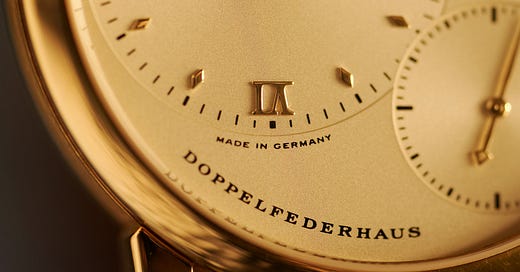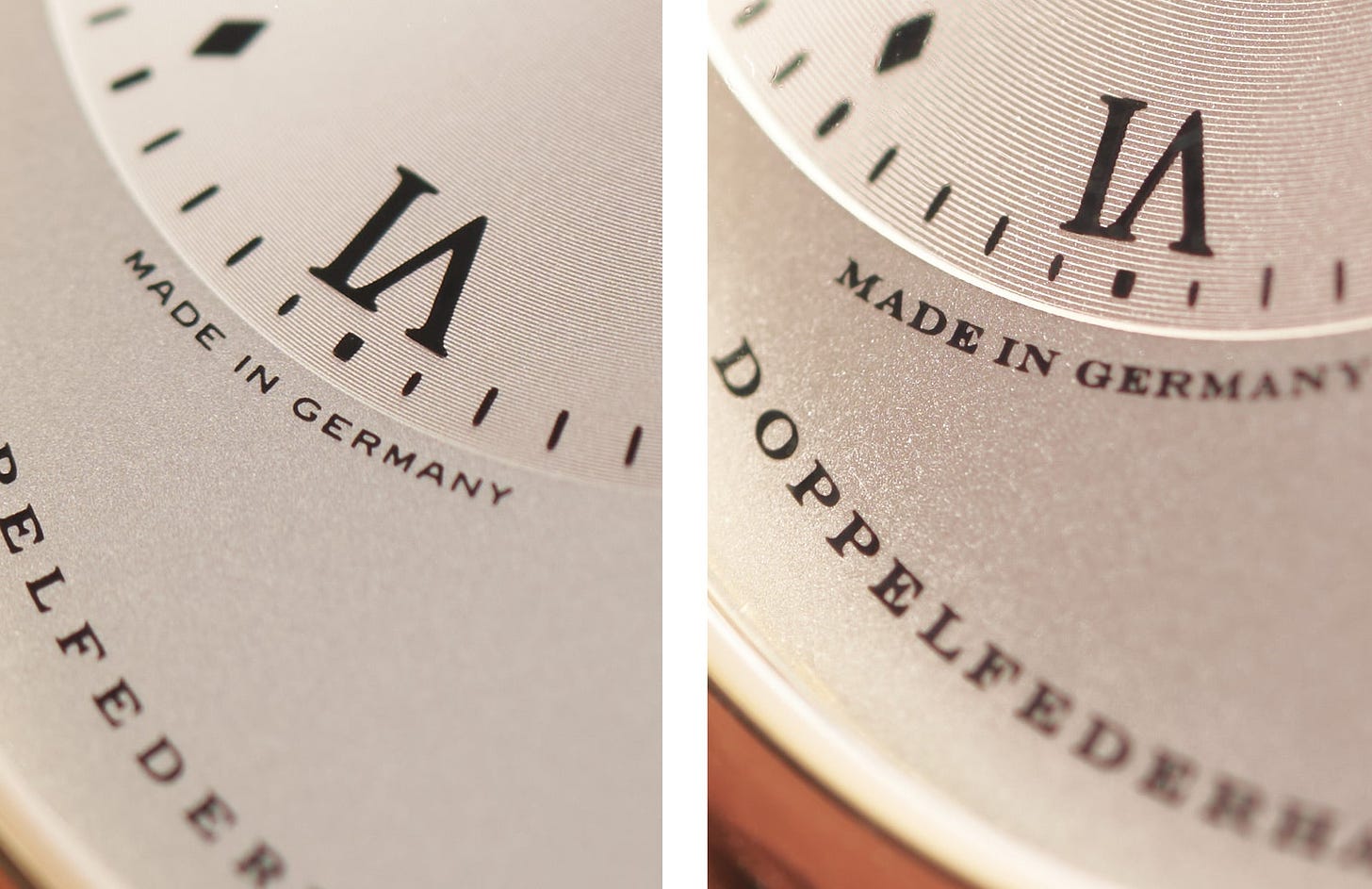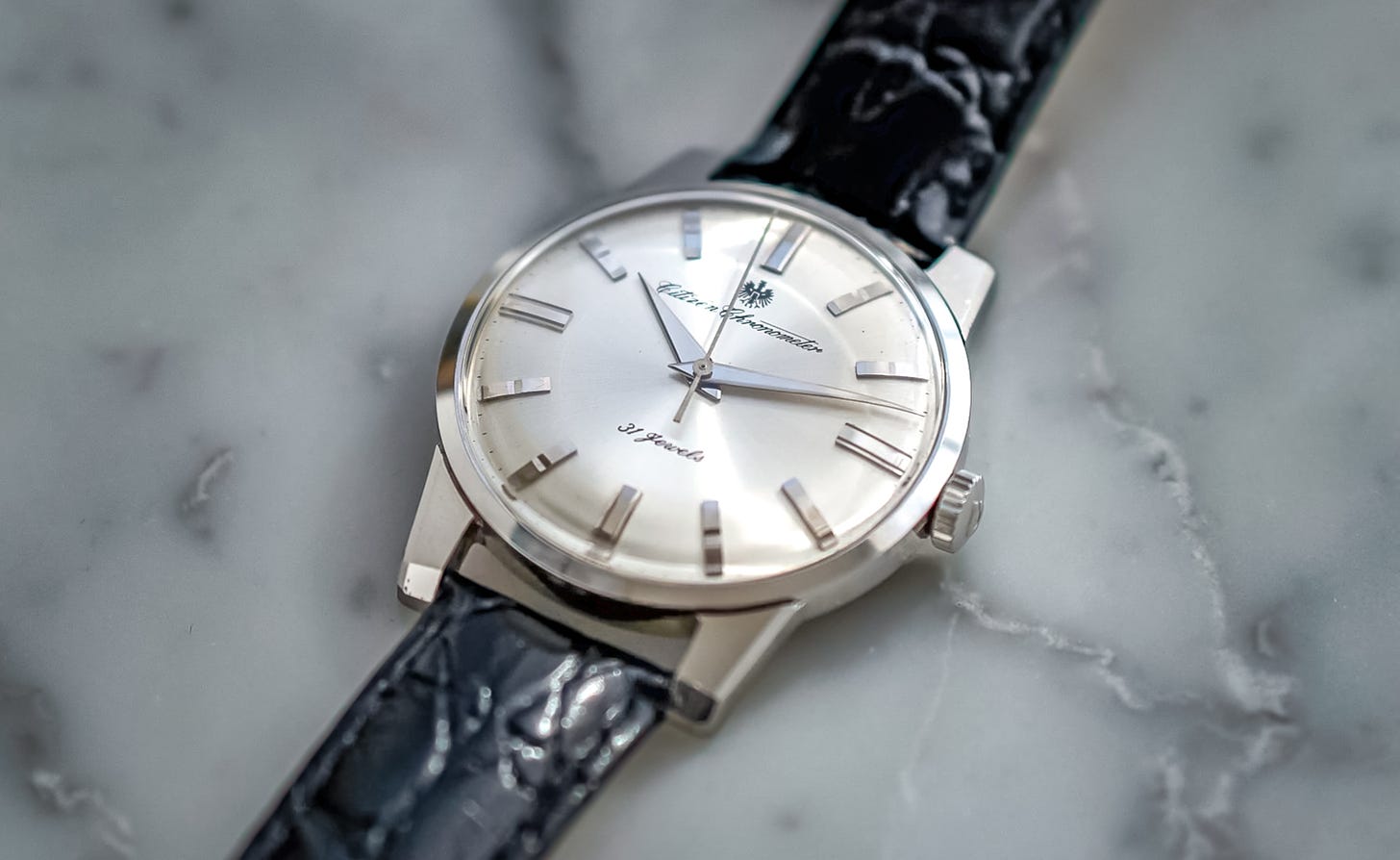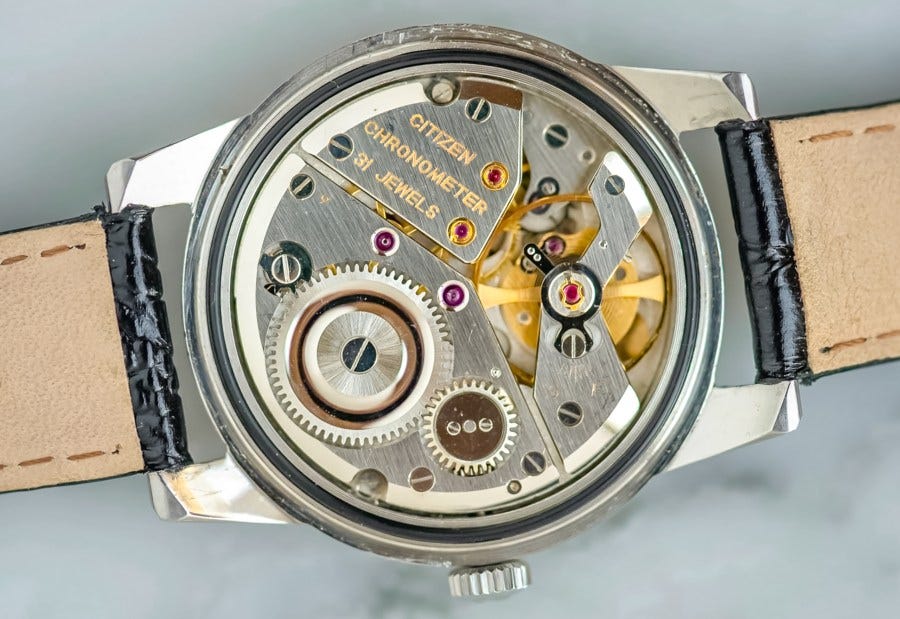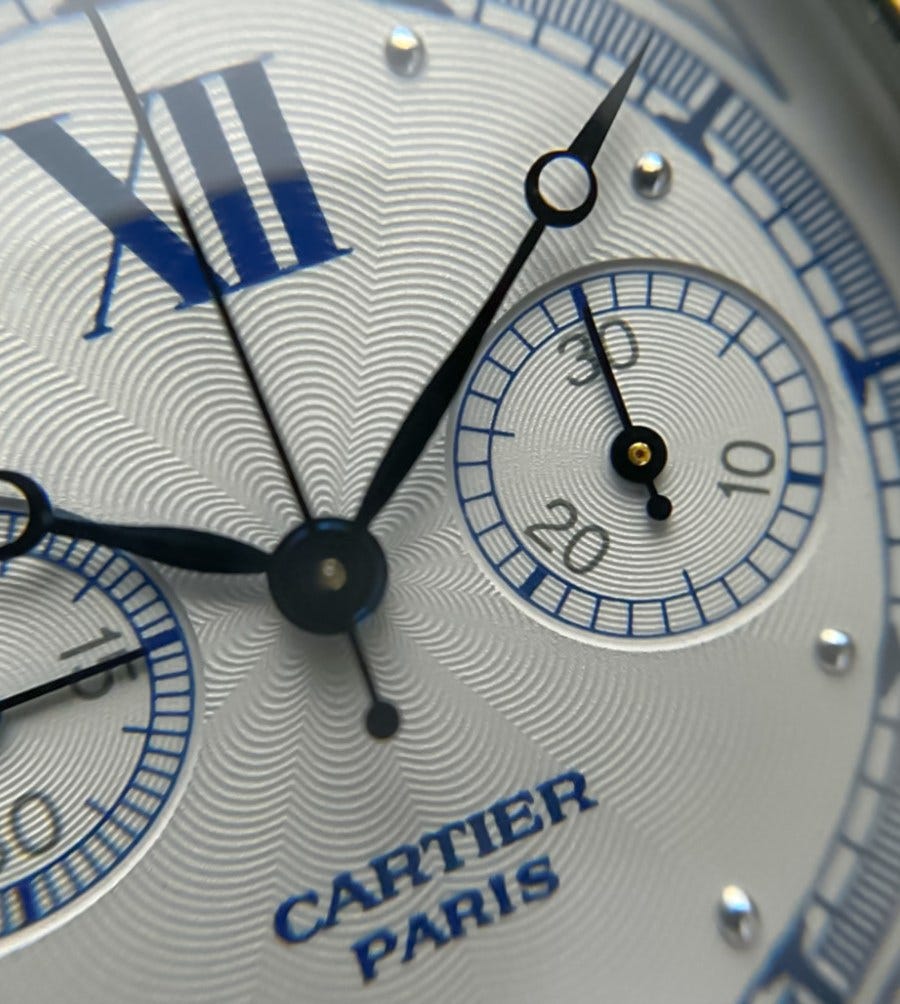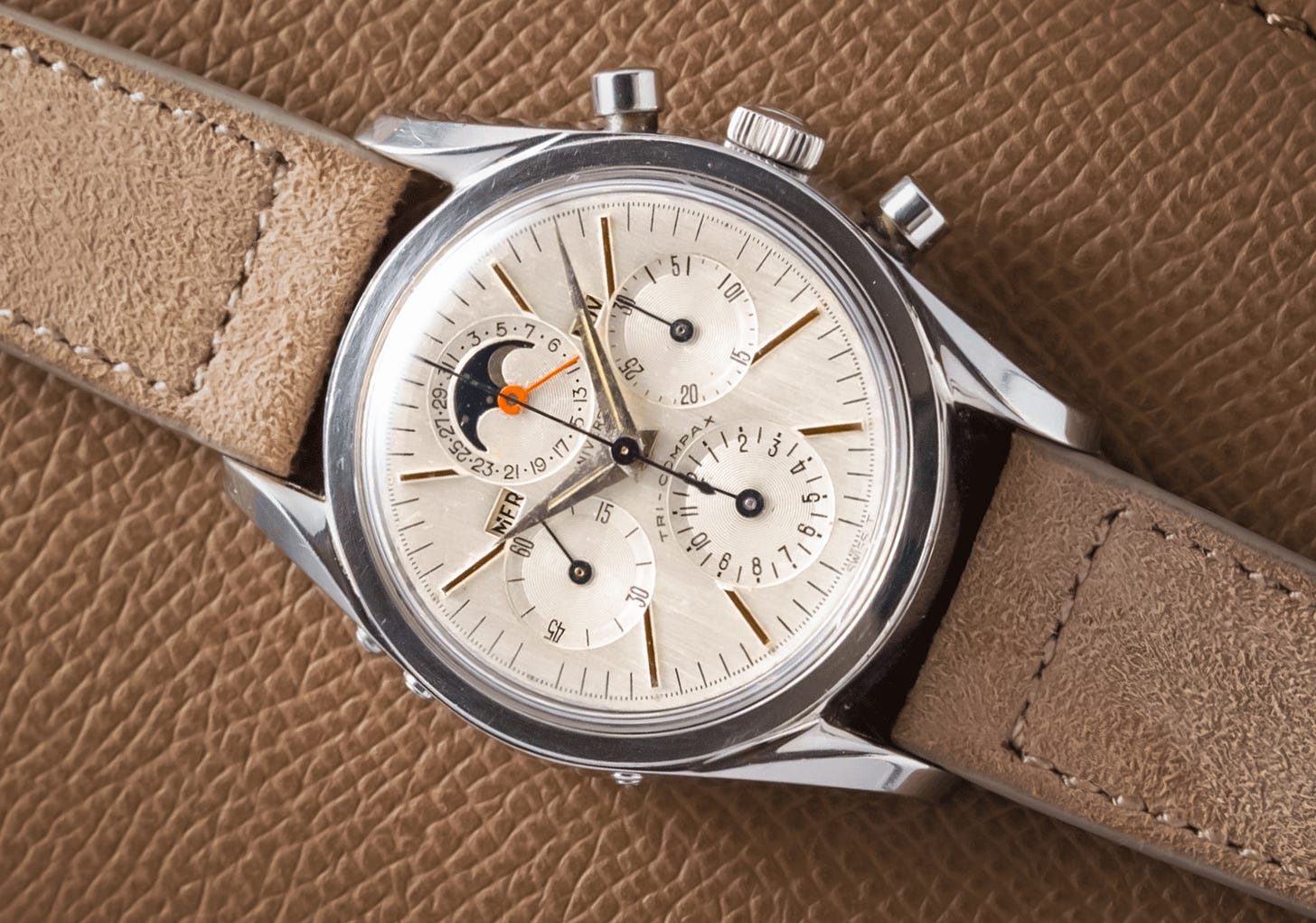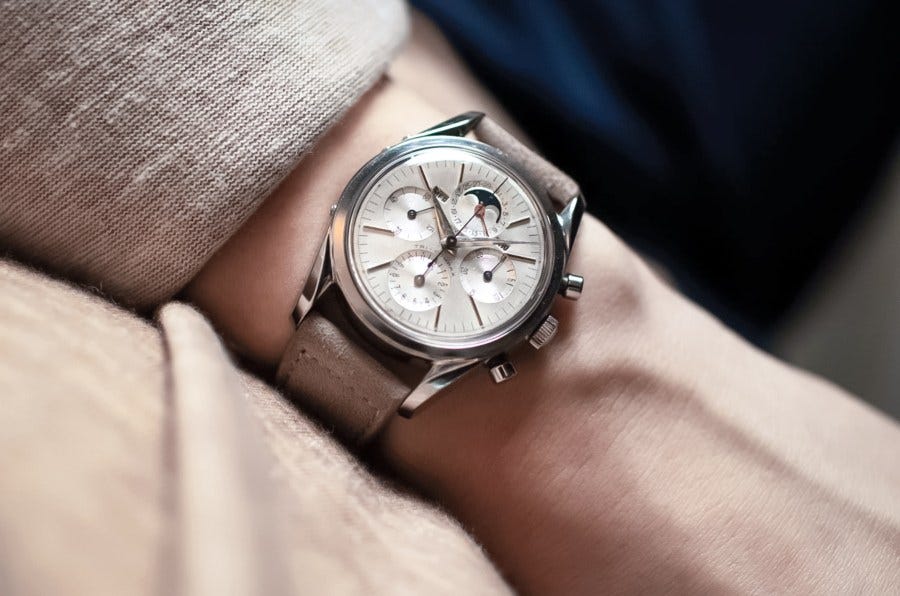Lange 1 and Let's Bring a Trailer
A deep dive into early Lange, and we 'bring a trailer' to take a look at some of the most exciting watches for sale on the internet right now
An in-depth look at early Lange 1s; then we ‘Bring a Trailer’ — watches style — with Hairspring and look at some of the best watches for sale around the internet. As a side note, Rescapement is also focusing on updating our website more in 2022, in addition to this ‘sletter, so make sure to check out Rescapement.com for all our latest.
Rescapement is a weekly newsletter about watches. To get magical dispatches like this delivered straight to your inbox, subscribe now:
Lange 1 - Made in Germany
Important scholarship illuminating the differences in early Lange 1s
At Rescapement, we love scholarship, especially in exciting new areas like neo-vintage. Take early A Lange & Sohne, for example. Lange’s most iconic model is the Lange 1, the first of four families it introduced in October 1994 when the brand re-launched.
Recently, Subdial published an important piece of scholarship about these early Lange 1s, Lange 1 — Made in Germany.
The Lange 1 collection developed throughout the 2000s, with variants featuring different dial colors and case materials added to the lineup. As Lange matured, however, it seemingly pivoted away from the more adventurous or unusual references, choosing to stick with tried and tested classical designs. Accordingly, these early Lange 1 watches have become highly collectible. These references, including the very first closed caseback models but also more inventive and contemporary designs such as the 101.035 “Darth” or the blue dial 101.027, have seen a spectacular rise in popularity.
To date, little has been said about the differences between early “first generation” Lange 1 examples and those that were released much later on.
Drawing on an experienced watch collector and a database of Lange 1s meticulously recorded over the years, Subdial has put together this article distinguishing between early Lange 1 dials, defined by their “early MiG” dials, and later Lange 1s, referred to as “later MiG.”

The discovery that opened this rabbit hole was the noticeable difference between the Made in Germany text on the dial, and this difference lends its name to the general term Subdial uses to describe the package of dial differences. The first difference is that earlier Lange 1 dials use a smaller and sans-serif typeface for the “MADE IN GERMANY” text which sits just below the central portion of the dial. Later examples use a larger text and employ the serif Engravers MT font which Lange is known for. This is the main difference between “early MiG” (for “MADE IN GERMANY”) and later MiG dials.
Subdial’s research into both case and annual production numbers indicates the transition from early MiG to later MiG took place sometime in the early 2000s. Because Lange’s annual production numbers were much lower in these early years when early MiG dials were being produced, they are substantially rarer.
This research also helps to identify watches with case numbers which likely would have originally been presented with early MiG dials, but instead feature later MiG dials — a dial swap likely would have occurred during a Lange servicing.
Subdial’s research also illuminates a number of other differences in these early MiG and later MiG Lange 1 dials, providing a valuable resource for collectors interested in understanding the Lange 1.
Currently, the market doesn’t differentiate between early MIG and later MIG dials, and it remains to be seen whether collectors will begin to do so. Knowing watch collectors, however, it wouldn’t be surprising if early MIG dials join the ranks of early Journes, Dufours, and others with their differentiated details noted and appreciated by passionate fans.
For the full article, Lange 1 — Made in Germany, head to Subdial.co
Hairspring: A curation of the best watches for sale on the internet
Featuring a Citizen Chronometer in Steel; Universal Geneve Compax; A CPCP Tortue Monopoussoir
Today, we’re doing something a bit different. One of my favorite follows — both website and Instagram — is Hairspring. The goal of Erik, who runs Hairspring, is simple: To curate the most interesting, rare, undervalued, or otherwise exceptional watches for sale from around the internet.
Ever day, he’ll post some of the best watches he finds from dealers and other sites around the internet. Having followed Hairspring for a while, his tastes are quite varied (and good!): vintage, neo-vintage, independents, and everything in between.
I am hoping to, on a regular basis in 2022, feature some of Hairspring’s picks here in Rescapement. There are tons of watches listed for sale every single day on the internet nowadays, and to me, Hairspring is one of the best at curating the internet down into a handful of picks.
I’ll let Hairspring take it away now by featuring three of the watches posted about over the past week. For the entire selection of 10 watches (Erik’s a busy guy!) Hairspring has posted in the past week, head to hairspring.com.
Let me know if you like receiving this selection of watches for sale and we’ll think about delivering Hairspring as a separate ‘sletter every week (perhaps one that you can opt in/out of).
Words by: Hairspring; photos to their respective sellers
Citizen Chronometer in Steel
Bear with me; this one requires some exposition. Even if I constantly strive to feature the most interesting and niche selections across the entire market, I’d like to think every now and then I can still surprise. Today, I’m surprised by how much mystery surrounds this Citizen Chronometer, how beautiful its designs remain, and how intricate its construction was. Sometimes the history of even the most benign watch can leave one speechless.
To the best of my understanding, the Citizen Chronometer was borne to demonstrate the marque’s flagship ability. Not just to rival Grand Seiko, but raise the entire name’s stock. Post-WWII, Citizen had seen steadily increased popularity in Japan, but not outside. That began to shift in 1959, when, to make a name for themselves, they launched Japan’s first water-resistant offering: the Parawater. This led to a series of more ambitious launches to flywheel Citizen into the worldwide zeitgeist, including the huge quartz push and Eco-Drive of the 1970s. It didn’t quite work out as intended, but that is the backdrop against which this timeless design rests.
The Chronometer was released in 1962. It carried an oversized balance (13.5mm) with ultra-fine adjustment which beat at a leisurely 18800 vph to ensure consistent amplitude over its laudable 53-hour reserve. The result was a chronometer spec -1 /+10s day. This is the antithetical approach of Grand Seiko’s 36000 angular cased, technological masterpieces. Citizen chose a classic (37mm) case proportion and movement architecture, but executed each with thorough attention.
It is said that the production and assembly of the Chronometer was entirely separate within Citizen, where one skilled watchmaker saw one piece’s construction through from beginning to end over the course of one day. This was the old way, from the Shokosha Watch Research Institute before it became Citizen. The line was not commercially a huge success, the process could not be scaled, and folded five years later.
This example sports a radially brushed silver dial with applied, beveled indices and dauphine hands. It is cased in steel though gold was also available. The text simply reads Citizen Chronometer, 31 Jewels. The case is razor-sharp. It comes from a midsize Japanese retailer, who called out that they acquired it from a well-regarded Citizen collector.
Find this Citizen Chronometer here from Arbitro for 5830 USD.
2396 Cartier CPCP Tortue Monopoussoir
CPCP was an incredible undertaking and era of Cartier but, for me, two stand above the rest. Cartier’s Tank and Tortue Monopoussoirs represented the best of then-contemporary independent watchmaking, unrepresented.
Let me explain. Think of the Monopoussoirs as a hipster’s 90s independent, with some of the greatest modern names contributing to its THA-ébauche calibre before it was cool to do your own thing. Journe, Flageollet (now De Bethune), and Vianney Halter all had a hand in constructing this truly impressive calibre that was unlike anything else. The monolithic Cartier then shrouded their work in classical elegance. Real scholarship has only formed in the last decade or so around Cartier’s CPCP neo-era and the significant strides independent watchmakers were making on behalf of the marque name.
What’s so special about this monopusher chronograph? The 045 used a clutch system and swivel pin to engage the chronograph wheel. These extra components remove the jolt that the central chronograph hand will experience with a lateral clutch. This was a lot of engineering, a ground-up chronograph redesign for a mono. All for the sake of an elegant chronograph engagement. Bridges and plates were decorated with the Cartier logo and finished to a high standard by hand. The dial is printed blue with a thick guilloché and Breguet hands. Around 200 of these calibres could be built yearly, and the CPCP ran from 1998 to 2008.
The 35x43mm white gold case is unmarred by time here. The elongated curved radius on either flank appears without dent. Its dial is perfect and calibre said to be running well. The watch comes with a full set with Cartier’s original deplyant clasp. It comes from a well-regarded Swiss retailer.
Find this Tortue Monopoussoir here from K2 Luxury for 69000 USD.
Universal Geneve Tri-Compax
For all intents and purposes, Universal’s Tri-Compax was the business as watches went post-WWII. Introduced at Baselworld 1944, the triple-complication (it’s often mistakenly assumed that “tri-compax” refers to the triple chronograph sub dial configuration) aviator’s offering was every bit as stylish as it was complicated. Derived from a pilot’s chronograph that helped win the war, the Tri-Compax incorporated a full calendar, moonphase, and chronograph within a vertically and horizontally symmetric dial configuration. It has been a true classic and lauded reference since inception, one which still feels perfectly designed nearly a century on.
Initial Tri-Compax references featured two dial configurations. The more common /2 variant featured a blue outer tachymeter scale. This /1 has long indices which extend all the way out to the chapter ring, giving its dauphine handset strong counterparts visually. The 36mm case incorporates Genta’s twisted lugs, first debuted on the Polerouter. Its moonphase date hand alone was finished in a spectacular red, set against a metallic blue golden wheel. All of this is contrasted with a linen/brush textured dial background. Models featured a signed crown and UG’s now-legendary calibre 281, a fully in-house, manually-wound, column-wheel calibre and one of the more technically sophisticated of the post-war era.
Simply put, this example is stronger than most. Its case is defined with a serial number still visible on back. The crown is signed. Lume is a deep gold but matched evenly across all applications.
Find this Linen Tri-Compax here from S. Song for 13500 USD.
For all of Hairspring’s picks, head to hairspring.com. And for even more, make sure to follow @hairspringwatches.
Through the Wire
🎧 Episode 6 of Significant Lots, where we chat important missing watches, hand out our first annual awards, and make some predictions for 2022. 🎤 An interview with Grand Seiko’s US president. 🔎 SJX goes in-depth with the new Patek Philippe ref. 6119 Calatrava. 🧑🎨 A look at Andy Warhol’s watch collection.
🤝 In other business news, Nordstrom and Watchfinder have formed a partnership to offer pre-owned watches on Nordstrom’s site and in physical flagship stores. I’ve always thought Nordstrom (along with Nieman Marcus, Saks, etc.) was a prime choice for a watch offering that’s more elevated than the Michael Kors, Movado, and other fashion watches it currently features, so this is an exciting/interesting move.
Rescapement is a weekly newsletter about watches. To get magical dispatches like this delivered straight to your inbox, subscribe now:


